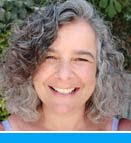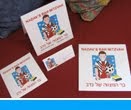Situated on the western edge of the Golan Heights overlooking the Hula Valley, the lookout served as a fortified Syrian military outpost complete with communication trenches and concrete bunkers surrounded by barbed wire and minefields. From this base the Syrians were able to fire down at Kibbutz Gadot just below the post and command the Bnot Yaakov Bridge (the name of the bridge is based on the belief that Jacob's daughters crossed the River Jordan at this point on their way to Israel). At the end of the Six Day War the Syrians fled from the onslaught of the IDF’s Golani Brigade and the site now serves as a memorial for the soldiers who fell conquering the Golan Heights.
A path from the car park lead us to a triangular monument naming the soldiers who fought here. The monument is built of concrete in the shape of a wing which faces east and symbolises the departure of the troops fighting in the Golan. Beyond the monument, there are a few decaying military vehicles left in place, along with a fence warning visitors to remain on the path. This area was heavily mined and is not safe to wander about beyond the fences.
At the crest of the hill we were treated to the panoramic view of Hula Valley we had waited for. The view was captivating and a clear reminder of the military importance of the location.
We listened to a recorded account of the events surrounding the 679th's actions during the Yom Kippur War, their arrival in the Golan Heights and the battle that followed. I'll skip to the end and say that the 679th won, despite having to fight as unprepared crews in unprepared tanks.
Next we stopped to view the 212th Artillery Corps memorial, above. This monument was established in memory of the fallen soldiers of Artillery 212 who were killed in battles during the Yom Kippur War. The monument consists of a concrete base on which are resting metal boxes placed on top of each other to create a spiral. At the centre of the monument are several aluminium poles that rise to a height of six metres. It was designed by the artist Hillel Pesach of Mishmar Ha'emek, who was the commander of the artillery battalion during the war. The monument was erected in 1976 alongside Highway 91 on the road from the Jordan River to the Golan Heights.
A path from the car park lead us to a triangular monument naming the soldiers who fought here. The monument is built of concrete in the shape of a wing which faces east and symbolises the departure of the troops fighting in the Golan. Beyond the monument, there are a few decaying military vehicles left in place, along with a fence warning visitors to remain on the path. This area was heavily mined and is not safe to wander about beyond the fences.
At the crest of the hill we were treated to the panoramic view of Hula Valley we had waited for. The view was captivating and a clear reminder of the military importance of the location.
En route to the Gadot Lookout we made brief stops at two smaller war memorials. The Golan Heights is an area which has seen many battles between Israel and Syria, primarily during the Six Day War and the Yom Kippur War.
Our first stop was at the Memorial to the 679th Reserve Armoured Brigade, below. The memorial features a black turret of a Syrian tank, surrounded by the names of the brigade's fallen soldiers. The turret has been placed on a sheet of metal supported by stones, with a Hebrew inscription which means "We will remember and not forget". The tank gun, to which metal wings have been fixed, juts high into the air.We listened to a recorded account of the events surrounding the 679th's actions during the Yom Kippur War, their arrival in the Golan Heights and the battle that followed. I'll skip to the end and say that the 679th won, despite having to fight as unprepared crews in unprepared tanks.
Then it was time to move on from war memorials. Our next stop was at Mey Eden Springs, also known as Einot Salukia, in the centre of the Golan Heights. Eden Springs is a collection of springs named after an ancient settlement that existed during the Second Temple period. The name Salukia is probably named after the Seleucid Empire that ruled over many lands in the Middle East for hundreds of years, up until about 2500 years ago.
Eden Springs is a lovely park which encompasses the Salukia Spring, which was the initial source used by the Mey Eden (Eden Springs) mineral water company. The spring is still plentiful, clear and cool and the park includes lovely pools where the water flows, shady areas, and easy paths, as well as information about the animals in the surrounding area.
The park is sheltered under the shade of Eucalyptus trees and river vegetation typical to the area: raspberry, common reed, willow and Nerium oleander. Between the trees are the remains of the Syrian village houses of Katsaviya El-Jadidah (New Katsaviya), which were abandoned during Israel's conquest of the Golan Heights during the Six Day War in June 1967. The name of the village is derived from the word "kasab", which in Arabic means Common reed. Between the houses of ancient Katsaviya, old relics of an ancient synagogue were found. It was believed to be one of dozens of Jewish settlements established in the Golan Heights after the forced exile of the Jews by the Romans from Judea to Galilee and the Golan Heights following the great revolt that ended in 70 AD.
Our next brief stop was at the 31 metre high Ayit waterfall (in Hebrew the word ayit means eagle) which unfortunately only flows after heavy winter rains. When we visited in September it was really just a trickle. In full flow the waterfall is one of the most impressive in the Golan. It falls into a deep canyon that stretches for 4 kilometres and flows into the Yehudiya River.
We followed a path from the car park for a few minutes, until the path forks. The left fork took us to a lookout where a sign explained the rock formations in the Golan. The basalt hexagonal pillars which we could see in the deep canyon are a unique geological phenomenon and can be seen on all the canyon walls of the Golan.
And then there was time to see just one more place before we headed home. Mister Handmade in Israel and I last visited Mitzpe Shalom back in 2014 but I knew that my dad would really appreciate the view from the lookout, so it was time for a return trip. Mitzpe Shalom, also known as the "Peace Lookout" or "Peace Vista", is situated on the high basalt cliffs of the Southern Golan Heights. The lookout offers what is hands-down the most spectacular view you’ll find in the area. Located next to Kibbutz Kfar Haruv, the members of Kfar Haruv designed the Peace Vista to signify their longing for permanent peace in the region. From the lookout you can readily spot the coastline of the entire Kinneret (Sea of Galilee). Across the Kinneret lies the city of Tiberias, easily viewed from Mitzpe Shalom. Up in the hills, it’s also possible to point to the city of Tzfat. Mount Meron, Kibbutz Kinneret (where the songwriter and the "First Lady of Israeli song and poetry", Naomi Shemer, was born), Yavne'el, the Jordan Valley and Mount Tavor are all visible from the panoramic Mitzpe Shalom lookout point. It is quite a comprehensive view! (Please make sure you click on the photo above to appreciate just how incredible it is).
* This post has been shared on All Seasons, The Good. The Random. The Fun. and Wordless Wednesday (on Tuesday).
* This post has been shared on All Seasons, The Good. The Random. The Fun. and Wordless Wednesday (on Tuesday).

























































































